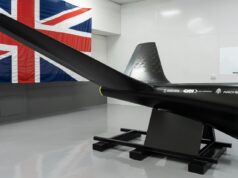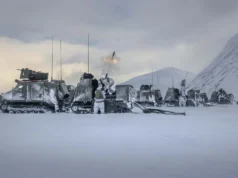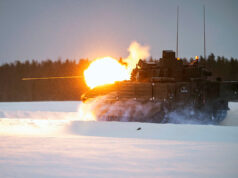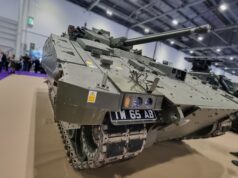It is no doubt that, despite serious issues, the SA80 was revolutionary in its design.
The rifle has a unique bull-pup design and was originally manufactured in Great Britain, in the Enfield works. However, while this rifle during its inception was touted as being revolutionary, based in part on its sci-fi appearance, its functionality came into question.
Soon after being adopted for service, problems began to surface. According to Anthony Williams in ‘SA80: MISTAKE OR MALIGNED’:
“…the first five years of this rifle’s service have been disastrous. A number of manufacturing defects showed up in service conditions, and it was not until the closure of the RSAF at Enfield and the setting up of an entirely new production line, with new computer-controlled machine tools, at the new RSAF Nottingham, that the quality of the production weapons began to improve. It will take some time for the poor reputation gained by the initial issue weapons to be overcome; the only consolation is that the same sort of thing has happened to other military rifles in the past, and they have managed to live down their early reputation and prove their innate reliability. It is to be hoped that the L85A1 will do so as well.”
The SA-80 is different to many rifles, as its magazine is located at the rear of the gun, behind the trigger. Firstly, the barrel length is longer to provide for accuracy and it is easily transportable. A paratrooper or armoured troops could use this gun, and actually, there is also a carbine derivative of this gun for use in the Army Air Corps, Royal Navy and other branches of services. It operates from a selective fire gas-operated design feature. As such, the weapon uses a short stroke gas piston located above the barrel, which is fed gas by a regulator. This is different to the M16 weapons platform which is based upon a direct gas impingement system. While the Colt M-16 is a very significant gun, it is prone to fowling in the chamber, as the spent gunpowder is still within the barrel, and it needs to be cleaned on a regular basis. Therefore, the SA-80 and its rotating gas impingement system have an advantage over its American counterparts.
The Bullpup layout means that the action of the rifle occurs behind the rigger system. This means that the design can be quite compact, and is achievable without compromising on its overall barrel length. The current barrel length of the modern SA-80A2 is 518mm. This makes this Assault Weapons system unique, and combat worthy in its current form. However, this has not always been the case as we shall see in this article.
The article is split up into three sections, with the history of the industrial design of the weapon, the deployment of the first SA-80 gun, and the design defects, thirdly, the attempt to remedy those defects by Heckler and Koch to create the SA-80A2 platform, and conclusion with a question as to whether we should carry on updating this design? Or should we purchase a superior weapons system – in my argument the Israeli ‘Tavor’ assault rifle, would be the best option?
Let’s start with the history of the rifle’s development. Its first prototype was named the EM-1 and the EM-2 respectively. The combat system started development in the late 1940s. The British government had an ambitious plan to change the cartridge of the new rifle and create a new type of assault rifle, which was different to the Lee Enfield bolt action rifle used in the Second World War. The experience of combat during the Second World War led designers to come up with a radically different new rifle concept – known as the EM-1 and the EM-2 (which were both of bullpup designs). These two prototype guns were supposed to have 7mm ammunition, however, political decisions at the top levels of NATO wanted to standardise its cartridges for small arms of member states to make it logistically simpler and easier to rearm. Therefore, when NATO adopted the current 7.62 x 51mm cartridge – otherwise known as the NATO cartridge, it brought a death knell to the revolutionary rifle development, and the government abandoned plans in favour of an off the shelf rifle. As such, the British Army adopted the Belgian FN FAL rifle.
Historically 1969 was the year, that brought this revolutionary design back on the table once again, and the Enfield factor began to consider a new type of small arms weapon system. In October, 2nd 1985 was the official launch of the new SA80 assault rifle in London. It was a crucial moment for the rifle to get the international recognition, with defence officials, and key industry specialists, generals, military attaches and journalists at the launch.
Gen. Colin Shortis who was at the time the British Army’s director of the infantry is quoted as saying at the official launch:
“We are delighted with the SA-80 – a really good weapon.”
However, the gun was actually not ready for the ceremony at all. It was kept a secret to the public. It was a testimony of the failure of the industry to fully be able to appreciate and understand the complexities of making a cheap, mass-produced gun for the Army. The industrial engineers who designed the gun never shot a gun, so in theory, their design looked good on the drawing paper, but in action, despite its science fiction appearance, this could not be further from the truth. In industrial design language, form and function were not matching the needs of the end user – in this case, the British Army infantry soldier being deployed on the front.
To quote the Guardian a series of defects became evident which included the following:
“The SA80 couldn’t be fired from the left shoulder making it dangerous to fire from corners and doorways. The firing pins broke, the magazine fell off, the bolt release button broke, the triggers got stuck, the cleaning kit wouldn’t clean, the butt plate broke, the cheek pad fell off, the check-pad melted, the cartridge cases wouldn’t eject properly, the bolt carrier didn’t fit properly, the locking pins holding the gun together were inadequate, and the safety catch wasn’t safe.”
When looking at the comparison between the original M-16 rifle made by Colt, and the original SA-80 to that of the AK-47 – the superior weapon to come out of these comparisons was ironically the Soviet Union’s AK-47 and its variant designs. This is a testament to how a simple manufacturing process, with a gun with a crude, but workable design, and 7 moving parts became one of the most prolific small arms in hot spots around the world.
However, the SA-80 had its first operations in Northern Ireland during the Troubles, and soon the FN FAL was replaced by these new bullpup designs. However, it was not until the First Gulf War that the true extent of the difficulties encountered by the infantry soldier of this design was uncovered. There were tales of British Army soldiers swapping their SA-80 rifles for AK-47s. The First Gulf War demonstrated the difficulties of fighting in desert conditions, with sand getting into the firing mechanism, and causing problems with the rifle’s ability to extract spent ammunition. The inability to fire meant that the Assault Rifle had to be cleaned during combat, and reassembled again in the hope of firing. This put lives in danger.
Due to the beleaguered nature of the rifle, the redevelopment of the rifle underwent a major update in 2002 by Heckler and Kock and the SA80A2 rifle remains in service as of 2017. While the SA80 rifles were upgraded to a new standard. This new design looked the same, but its internals was different. Also significant was the adoption of the railing system at the barrel which allowed for the inclusion of a grenade launcher. Also, a hand grip was introduced on the rail, which allowed for greater user-friendly experience, and better targeting of the rifle.
As quoted on the website Army-technology.com, the new rifle has:
“The rifle features a revolving cylindrical bolt integrating locking splines, an extractor and casing ejector. The rotation of the bolt is ensured by a cam pin. The fire-control lever allows the operator to select semi-automatic fire or fully automatic fire. The flash suppressor on the barre acts as a base for mounting grenades and a blank-firing adaptor or a bayonet.”
These updated rifles went into action with the British Army and saw service in Afghanistan and Iraq, as well as Sierra Leone and other conflict zones where British troops were deployed. Overall, the SA-80 has been deployed to the following conflicts including the Troubles in counter-terrorist operations in Northern Ireland, to the Bosnian War in peacekeeping operations, the Kosovo War, under peacekeeping missions to the Sierra Leone conflict, the Iraq, and Afghanistan Wars.
Another interesting point to highlight is that there are a number of users of this platform, which enhances its credibility as a weapons platform. As part of British Aid, Zimbabwe had the SA-80, it has been used by Bolivia, in particular by its Special Forces, by Jamaica since 1992, Mozambique, and Nepal both part of British military aid, and Papua New Guinea. Over territories include Gibraltar as it’s the standard rifle for the Royal Gibraltar Regiment, and also used in Bermuda by the Royal Bermuda Regiment.
To conclude, while the original SA-80 assault rifle was seen to be a more accurate design it was beleaguered with problems which could only be remedied by a refit of the system in the form of SA80-A2. The government had to spend around £500 million according to some estimates to make numerous modifications and upgrades to make the weapon systems better. Now according to Janes Defence Weekly, there is a potential for an SA-80A3 version which could extend the weapon system lifespan to beyond 2025.
The main questions become: should the Ministry of Defence be looking for a more up to date weapon system? In addition, should it consider a weapons system being purchased from elsewhere?













“Potential for an A3 version”!! It’s already in production and has been launched. Catch up UKDJ!
Why is my comment awaiting moderation still?
Its awaiting UK MOD paper work?
Not yet – the US is doing a lot of work on a 6.5 – 7mm round and it looks as if the days of the 5.56 are over, but like everything it will take time.
I think we wait and see what happens with the calibre’s and then make a decision. The SA80 works and is good, we should look at managing whatever stocks we have with a view to retiring in 2030’s.
When Margaret Thatcher was frantic to sell off the state owned Royal Ordinance Company she added a sweetener of a large order for this rifle even though she was told that the development was not finished and it was not ready for use.
Ordnance
Good article – but it doesn’t cover the options and your preference for the Tavor in it.
It doesn’t have the range nothing they found out out is it can’t engage at the distances the the Taliban engage the troops at by using older weapons such as the Lee Enfield and the like that’s why they had to bring in the sharpshooter and the yanks produced a weapon with two interchangeable barrels to engage at longer distances I wouldn’t want to go into combat with sa80 give me the sir anyday
Having used both A1 and A2 versions of the SA80 as well as a number of AR15, AK and HK variants, I can honestly say the SA80A2 is the most accurate assault rifle on the market. However, the design is not battle friendly!
When you use a weapon over time you develop muscle memory for carrying out repeated functions i.e. magazine changes. The AR15, AK and HK family of weapons all place the magazine in front of the trigger. This is ergonomically intuitive and over time you no longer need to look at how to change the “mag” as it becomes instinctive. This cannot be said of the SA80, because of the placement of the magazine relative to your body. When wearing body-armour and all the other kit, you have to look at what your doing, as things get in the way or can get caught. One of the tricks was to extend the rifle in front of you when kneeling to ensure nothing got caught, but this takes time and is no longer a fluid action.
Therefore when fighting in close order, the weapon with the “mag” in front of the trigger was better. Having never used the FN P90 with the magazine on top of the barrel, I’m not sure if this would be a better route to follow?
Agreed Pacman, now HK are also making replacement receivers as well as all the other major action components, they can carry on in service well into the 2030’s.
No point replacing the system until a new NATO calibre is selected.
The rifle is still too heavy, has terrible ambi controls and is a mess to dissassemble. The tavor has already been replaced by the X95 in Israel to make it even shorter and include a button release. I would replace it with the LMT MARS.
The tavor has already been replaced by the X95 in Israel to make it even shorter and include a button release.
Still the Tavor, just the latest iteration.
Even the Falklanders were not prepared to use the SA 80.
No one would argue that the rifle has terrible ergonomics (training largely negates this issue) or that its too heavy, that aside, its here, its reliable, accurate and effective.
HK support the L85 and continue to refine and upgrade the rifle.
When a new calibre is eventually selected (no hurry here, its not a funding priority) , a new off the shelf design will replace it.
It is no doubt that, despite serious issues, the SA80 was revolutionary in its design.
No, that accolade belongs to the EM1 and EM2 using a 7mm round which was actually superior to the the NATO standard 7.62 and its successor the 5.56. Ironically after rest of NATO followed the US in adopting the 7.62 round at the behest of the US, they then decided to adopt the 5.56mm and as we have seen, that round isn’t fit for purpose.
However, while this rifle during its inception was touted as being revolutionary,
The SA80 was adopted into British Service in 1985, the Austrian Steyr Aug (and used by quite a few other countries) got their first in 1978.
in my argument the Israeli ‘Tavor’ assault rifle, would be the best option?
Agreed 110%
As someone who owns both Tavors and AUGs the Styer A3 and Aussie F90 variant of the AUG edges it out due to adaptability. For example in order to change the ejection for a left hander on the Tavor requires an Armorer. On the AUG it is a change of bolt and swapping the ejection port cover during field stripping. Also while all three are well made the Austrian and Aussie made guns just feel quality. Not to mention both are lighter and carry more naturally. However the Tavor is significantly cheaper in the US than those 2.
“… in order to change the ejection for a left hander on the Tavor requires an Armorer”
No, it just requires time and patience. Irrelevant now, as the X95 fixes that time-consuming annoyance over the TAR-21.
A Tavor or X95 requires 15-20 minutes to change over. Also tools and more knowledge and tools than your average user has. I have done the conversion myself on both the TAR-21 and X95 so I know it isn’t hard IF you know what your doing. The amount of time makes it for general service purposes a job for the Armorer not a Private shooting his or her first rifle. As in many countries this would be their first exposure to firearms outside of the movies.
The AUG is a swap of bolt while teaching that trainee how to clean and preform basic maintenance. One of the first lessons learned by a professional service so easily included in the basic training regimen.
@Elliot
I take it you live in the US if you own those rifles.
I live in the US and I’ve seen the Tavor rifles, X95s, Steyr Augs and they’re pricy. AR15s are more economical to buy. I don’t have any experience with bullpups.
Just for the info the SA80-A3 was displayed in 2016:
http://www.combatandsurvival.com/uk-news/7908-new-sa80a3-assault-rifle-revealed-dvd16
The A3 marking is applied to designate newly HK manufactured receivers.
It doesn’t represent a major upgrade in itself, just minor manufacturing improvements to the original designed body.
This is a crucial steppingstone to future improvements that will include new forend, full length rail and other mods.
The SA80 was on display at the Queens Silver Jubilee at Sennelager in 1977. At the time it was designed for both left & right handed filters. Bit to save costs it the became only for right handed filters.
I have a plenty experience with the L98a2, through cadets, and limited experience with the L85a2, so I am clearly no soldier but I want to express my own opinion.
It’s a decent rifle, the 20.4 inch barrel let’s it outshoot most AR15 designs (getting better performance out of 5.56) and the ami problem not a major problem as British forces are all taught to fire right-handed, and for CQB soldiers are taught to fire instinctively, placing the rifle against their chest, so their body is never exposed without their rifle being able to fire.
As a result I think the best way forward is to upgrade the rifle to the ‘a3’ variant presented by HK, whilst developing a new bulpup rifle, based on the SA80, that will have interchangeable calibers etc (basically what the sa80 was meant to be before budget cuts and design struggles occoured).
I am against adopting rifles such as the tavor or even the aug (and lithgow F90), as the polymer designs are generally weaker than their metal counterparts ,(why do you think the us haven’t adopted polymer parts for their rifles, even though parts are readily available). Therefore an aluminium alloy would be the best alternative as it is tough, and light.
For the mechanism, ambidextrous functionality would be pleasant, however not required (for reasons previously mentioned), a simple Forward ejections system could solve many issues found with the current design. Most importantly the rifle needs to be kept simple and modular so multiply variants are possible.
To summeriese, we should keep the sa80 in service until around 2030, whilst developing a new rifle design with HK.
If this idea is completed correctly we could have a world leading weapon that could attract foreign purchases.
The Austrian STEYR was produced after the FRENCH Famas F1 which entered initial service in 1971, variants – the G2 et al are still used today.
I liked this article, but I have a few issues with some of the content. Some sort of conclusion on the combat effectiveness of the SA80A2 would have been nice, as would a discussion of what the future might hold for the weapon system in terms of further development or replacement options.
Having used all models versions of the SA80
system I would disagree that the A2’s internals are entirely different from those of the original model. They have been improved on, and certain parts such as powder coating, extraction face, cocking handle design, gas parts, blueing etc have been modified and greatly improved; but the basic cam-operated bolt carrier is fundamentally the same design from the original.
Also, this article needs a really good proof-read for spelling,
Punctuation and grammar. (Pro tip: rifles suffer from fouling, not fowling).
The ADF also has longstanding operational experience with a bullpup design, introducing the Steyr AUG as the Australian Army’s principle infantry weapon in 1989. Variants of the Steyr have seen service with 30 different countries, including New Zealand.
The original F88 version, manufactured under licence from Steyr-Mannlicher AG in Australia at the Lithgow Small Arms Factory, had a number of Australian specific modifications including a different rifling pitch and a heavier 62-grain NATO-standard round.
Since then there have been continuous evolutionary improvements to the weapon. The F88SA1 variant introduced an integrated Picatinny rail to allow fitment of mission specific optics and night vision scopes. The F88SA2 was fielded in Afghanistan with refinements including a modified gas system for better reliability and increased interoperability with US ammunition.
The most recent variant Enhanced F88 (EF88) is part of the LAND 125 Soldier Combat System project and is currently being issued to Australian Army units including those on operations in the Middle East as part of Operation Okra.
This variant delivers further reductions in weight and improvements in the balance and handling of the weapon along with additional Picatinny rails to accommodate a wider range of optics and attachments as part of a ‘tiered’ combat system. It has become over time a reliable, accurate and sophisticated weapon system.
http://www.thefirearmblog.com/blog/wp-content/uploads/2017/03/image1.jpg
The F90 is an export version of the EF88 which Lithgow Arms is now using to chase foreign sales. Given that Lithgow Arms is now a subsidiary of French conglomerate Thales, the F90 is being proposed by Thales in partnership with Steyr-Mannlicher for the planned replacement of the FAMAS rifle in service with French forces. Dasan Manufacturing will be licensed to manufacture the F90 in South Korea as a potential replacement for the Daewoo K2.
http://www.lithgowarms.com/f90/
Lithgow’s investment in their pull pup design is continuing with recent release of F90 MBR (Modular Bullpup Rifle) a further evolution of the F90. Principle changes appear to be a smaller butt stock, use of STANAG magazines and compliance with US SOCOM standards for ‘swimming’ the weapon – perhaps chasing potential marine and special forces sales.
http://www.lithgowarms.com/f90mbr/
By contrast the NZDF has decided to move away from the bullpup design of the Steyr they had originally introduced in parallel with the ADF. US manufacturer Lewis Machine & Tool (LMT) will supply their modernised CQB16 version of the venerable AR-15 design that forms the basis for US equipment. Lithgow Arms did not enter the EF88 in the NZDF competition for their new assault rifle.
Unlike the ADF which has invested in upgrading and modernising the Steyr, the NZDF were still fielding the original fixed optic version of the Steyr introduced in 1985 which are more than 30 years old so the new kit is long overdue.
As an aside, the Steyr has also been a long time Hollywood favourite featuring in the original Die Hard movie and more recently the Aussie EF88 can be seen in the latest of the Alien movie series Alien Covenant.
I wouldn’t worry to much about the SA80 having a rocky introduction. Just have a read about the US M16 and even the Lee Enfield 303. I think the only thing they need to work on for the future is it’s weight. Apart from that it’s probably the finest assault rifle in the world.
“Let’s start with the history of the rifle’s development. Its first prototype was named the EM-1 and the EM-2 respectively.”
NO NO NO NO and NOOOOOO!
The EM-1 and EM-2 are not and never were prototypes for the SA80, I was hoping a decent blog this wouldn’t perpetuate this myth! Nearly twenty years separate them and they are entirely mechanically different. The EM-2 was put forward for NATO trials alongside its 7mm ammunition but the Americans rejected a drop from a .30 calibre round. The EM2 couldn’t easily handle the 7.62×51 cartridge so after initially throwing our toys out the pram we adopted the American cartridge and the Belgium FAL (the FAL itself could barely handle the round).
The most that could be said is the MOD and Enfield returned to the idea of developing and implementing a bullpup, they continued to toy with the concept of a Bullpup through the sixties before launching on a new program using the AR18 bolt and gas system as a basis.
Its often been said that the L85 is nothing more than an EM2 with an AR18 shoved up its arse!
Joking aside, you only have to put an L85 and AR18 bolt group side by side to see the blatant rip off perpetrated by the MOD and industry.
Not for the first time either, UK government/ nationalised industry has a long history of ripping of others intellectual property rights in this country … Look at the L2 Sterling SMG and the .38 Enfield revolver.
The Government set up L2 SMG manufactue at Fazakerley (without Sterling Armaments permission) and Enfield’s .38 revolver was a direct rip off of Webleys design..
Sterling took the MOD to court over infringing their patent for the L2 SMG and won in 1966. Whilst ROF were allowed to finish their contract they couldn’t export them and a fee had to be paid back to Sterling. Not the first time or last time it would happen, apparently there was a fair amount of bad blood between RoF/RSAF Enfield and Sterling over the years!
There’s a great 1980’s picture of a joke Sterling AR18 “bullpup” assembled from scrap parts at the Sterling factory for the wind up value.
Great piece of Sarcastic humour!
https://www.youtube.com/watch?v=4WtOOLh_F8I
the weapon is utter trash. if I could get my hands on a sharpshooter, I chose that every time. it works like it should and went where the sa80 couldn’t.
the sa80 a terribly built weapon. wobbly TMH, loose sight rail, shit trigger pull, worn out barrels that will never get changed, parts damaged by over zealous cleaning regimen. the list goes on. the only saving grace is the elcan LDS we use on it, although the ACOG was alot cleaner and easier to adjust.
There is however work on a future weapon system, a joint effort with the USA. We’ll see what happens with that.
We do trial new stuff all the time down in Warminster but it never filters through the channels to the lads. the army are, as suggest by the US and our own retired generals, stuck in the past.
Ahead? No i would say steps backwards after churchill canceled .280 which is it were very advanced would put us further ahead as churchill want following American standards 7.62x51mm which suitable open field rather urban warfare and overpowering (high recoil), British were against it, Americans refused use british as want American bullet even they knew british is better in all round term results some other nato want british version but churchill want all following as if we fight soviet and all other countries to save logistics nightmare, if all different size ammo in end 7.62mm picked due American preferred.
That we go further step backwards again when 5.56x42mm is weak underpowered and suitable in urban but not in open field. That why tabilans able fighting easy in long range engagement on them and we often call air strike or cas helicopter, even fire javelin missiles to them.
If we use .280 we be better in engagement to them as it is balanced weapon like “goldilocks”
It is waste money to buy 2 services of ammo when there answer .280 that reason American start look at 6.25mm to 7mm. Ironically if they pick british one in 1950s would save us time and also money.
Anyway back to topics about sa80:
I would suggest we bring back .280 or research 6.25 to 7mm.
Would be nice see british use hk416a5 with convert to .280 or desert tech mdr with convert to .280 to replacement sa80a3
Also L128 convert to .338 lapua and heavy mg with .338 lapua to save money bullet logistics cost, also minini convert to .280
No offence as sa80a3 is great gun but that cartridge bullet is let us down. It is politically mess not sa80 fault.
also redesign em2 to new rifle for 5.56mm to make sa80 problematic in start of service which is shame to see it struggle evolved into mature platform yet in wrong time as we start to look replace it to short life of sa80a3 in 2025s
“It is politically mess not sa80 fault.” I agree. There is often a disconnect between what the Military wants to do with a weapons development and what the politicians will allow or budget for.
the size and weight , design is not the question. it is The stopping power of the ammo. the 5.56 is great up to 100 metres beyond that it can take several rounds to drop a man. 7.62 will put a man down up to 300m and beyond. but the SA80 is great for built up areas as a close quarter weapon, compared to the SLR.
Peter. You will be glad to know that the age old argument concerning 5.56 VS 7.62 is now being superseded by new cartridges. In the distant future when I am old and retired, reagardless of what the current infantry cartridge debate is, I fully intend to bait people into arguments about them. Maybe by then we will be debating the “Green Laser m650 vs the White Laser M673” Glocksters will then be claiming that only Glock makes a decent hand laser. I will swear to them that the Glock hand laser pistol triggers all suck.
“Ahead of its time?” Hell NO! It was issued AHEAD OF REASONABLE TESTING AND DEVELOPMENT. The concept was and remains fine. Not everyone wants a bullpup but not everyone wants any service rifle in history. We all have our preferences.
Other examples from my side of the Atlantic: Some folks hate the US SCAR. I am fine with it. The gas system has to be adjusted for the ammo. Hence. The ammo has to be correct to spec vs “my-cousin-is-a-Senator/MP contract ammo.”
The M-17. I am fine with them and have had no problem with them. Some people with more combat experience than I have are condemning the M-17. The right ammo will have to be agreed upon to properly match the gas system. New adjustments in manufacturing are already being made.
Have you heard about the original M-16? The lovers of the heavier M-14 hated it and were caught actively sabotaging the M-16. A particular colonel should have been hanged but he wasn’t. Poor ammo was sent to Vietnam with the troops and it resulted in more USA soldiers and Marines dying until the issue was resolved. The M-14s greatest supporters in the Pentagon never carried a rifle in combat. They didn’t care how much the rifle and ammo weighed. They were never going to carry it so who cares about weight? Foot soldiers care. Now, the well developed M-4 (a shorter/lighter M-16) is very popular. I prefer and am allowed to carry something with more Muzzle Energy and Muzzle velocity. I don’t dislike the M-4. Its great in CQ. I just like something heavier for my particular job and I pay for that choice in my load out.
Lets, for a moment discuss something as simple as the optics employed. Research showed us that Veterans who trained first on the ACOG tend to prefer it over iron sights. Veterans who trained first on iron sights tend to prefer iron sights.
No rifle design will be adequate without proper testing, development, redevelopment and proper logistics. Even the best rifle is useless if we miss or fail to act in time. I never carried a UK rifle in combat. I have used them on ranges so with my limited experience I feel the SA80 was a GOOD design and just needed what every rifle needs, proper development, proper support, proper training.
PS Was the UK 1895 Enfield 303. British Rifle “before its time”? Perhaps so. Now in 2025 I own three of them and they remain reliable and fairly accurate. I have given a few others away as gifts.